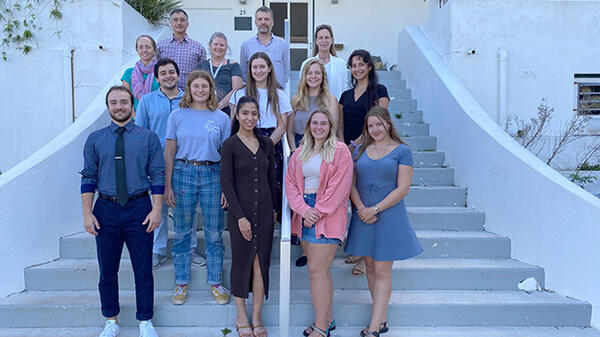Hourly measurements show when and how the ocean produces, recycles, and exports carbon — and why salps matter more than we thought
New Study Using Ocean Gliders Uncovers Clues About Carbon Cycling in the Sargasso Sea
December 11, 2025

Fall Interns Team up for Ocean Science Research Experiences
January 27, 2022

In 1991, BIOS became a site for the competitive and prestigious National Science Foundation (NSF) Research Experiences for Undergraduates (REU) program, which provides participants with the opportunity to work alongside the Institute’s faculty and staff on research projects in a variety of topics in ocean sciences.
A Nose for Nitrogen
June 08, 2016

Damian Grundle, on board the research vessel Atlantic Explorer, recently joined the BIOS faculty.
A Microbial “Whodunit”
July 09, 2016

An interdisciplinary team of scientists joined forces in July for their first annual research cruise dedicated to revealing how specific microbes take up and transform organic matter within a web of ecological interactions in the waters southeast of Bermuda.
MAGIC Room Opens at BIOS
August 10, 2016

BIOS welcomed the first student users of its new high-tech facility known as the MAGIC Room—a room designed to facilitate data analyses, scientific collaboration, and learning among students and visitors from Bermuda and abroad. Students sat at a large, U-shaped table in swivel chairs that pivoted for views of multiple screens, including a multi-screen video wall at the front of the room and an 84-inch high-definition touchscreen on an adjacent wall. As underwater gliders roamed the ocean 50 miles away, students discussed the gliders’ near-real time measurements of oxygen, salinity, current strength, and other incoming physical and chemical data.
Out to Catch a Spring “Bloom”
April 13, 2017

Each spring, when daffodils and other flowers emerge in gardens, tiny ocean plants called phytoplankton also undergo a surge of production and rapid growth near the surface of the Sargasso Sea. Although each marine phytoplankton is small—tinier than the period at the end of this sentence—it carries tremendous responsibilities.
BIOS-SCOPE Funding Renewed
November 30, 2020

After five years, with more than 25 papers in peer-reviewed scientific journals, six dedicated research cruises, and more than 45 presentations at national and international meetings, the BIOS-SCOPE (Bermuda Institute of Ocean Sciences – Simons Collaboration on Ocean Processes and Ecology) program has received five years of additional funding from the Simons Foundation International to continue its study of the microbial oceanography of the Sargasso Sea.
‘A Fantastic Boost for My Career’
November 29, 2020

Naomi Villiot knew the path to research abroad during a global health crisis wouldn’t be easy or simple. However, “after a great deal of paperwork, navigating canceled flights, virus testing, and isolation for days upon arrival in Bermuda in September, I have been able to continue with my research,” said Villiot, who hails from a small island in France and studies at a British university.
New Insights Bloom from BIOS-SCOPE’s First Year of Data
August 13, 2017

Sampling offshore Bermuda this July, the BIOS-SCOPE (Bermuda Institute of Ocean Sciences – Simons Collaboration on Ocean Processes and Ecology) program completed its first full year of study to learn how marine microbes produce, transform, and leave behind dissolved organic matter as the seasons progress, and microbial communities wax and wane.
A Shark Attack on Glider Jack
October 14, 2017

Not long after sunrise on July 24, a BIOS-operated ocean glider named Jack climbed slowly from a depth of nearly a half-mile offshore Bermuda toward the sea surface as it’s sensors collected and measured ocean properties, including temperature, salinity, oxygen, chlorophyll, and currents. It was a routine operation for Jack, an airplane-shaped vehicle that has traveled a similar path thousands of times over the past two years for BIOS researchers in the Sargasso Sea.